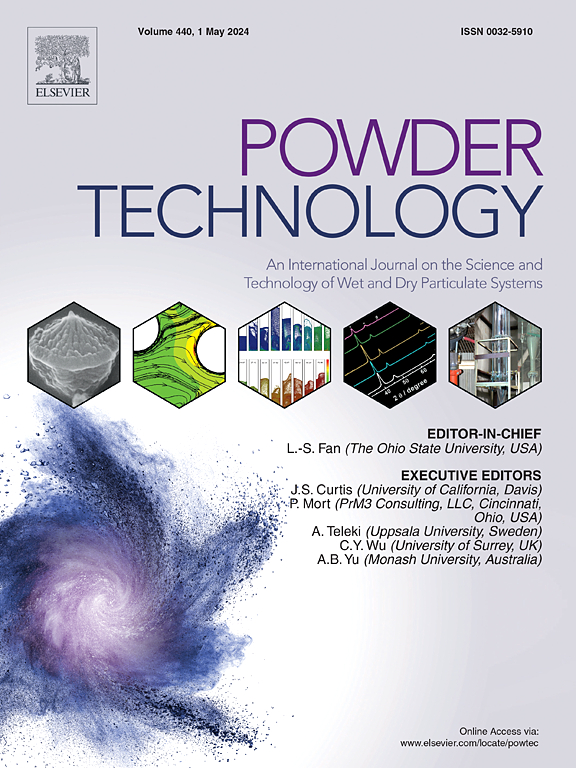机械化学法合成低成本高岭石基钴蓝复合颜料
IF 4.5
2区 工程技术
Q2 ENGINEERING, CHEMICAL
引用次数: 0
摘要
钴蓝(CoAl2O4)颜料以其亮丽的蓝色和优异的稳定性被广泛应用于涂料、玻璃、陶瓷、塑料等各个领域。然而,传统钴蓝颜料制备方法的高能耗和污染,以及钴资源的逐渐枯竭,导致生产成本高,阻碍了其进一步采用。在本研究中,我们通过机械化学法和煅烧工艺制备了新型高岭石基CoAl2O4复合颜料,显著降低了钴的消耗。实验结果表明,当碳酸钠的添加量为450%,高岭石的添加量为40 wt%, Co与Al的摩尔比为0.14,煅烧温度为1100℃时,所制得的复合颜料具有最佳的蓝色(L = 56.62, a = 4.50, b = - 49.92, C = 50.12)和良好的化学稳定性(∆E≤1.15)。进一步的表征分析表明,显色性能的增强主要是由于高岭石表面均匀分散的高结晶度的CoAl2O4颗粒,使其对蓝色可见光具有较强的反射率。因此,本研究有望为高效环保的钴蓝复合颜料的制备提供参考。本文章由计算机程序翻译,如有差异,请以英文原文为准。

Synthesis of low-cost kaolinite-based cobalt blue composite pigments by eco-friendly mechanochemical method
Cobalt blue (CoAl2O4) pigment is widely used in various fields such as coatings, glass, ceramics, and plastics due to its brilliant blue color and excellent stability. However, the high energy consumption and the pollution of conventional preparation methods of cobalt blue pigments, as well as the gradual depletion of cobalt resources, lead to high production costs and hinder its further adoption. In this study, we prepared novel kaolinite-based CoAl2O4 composite pigments through a mechanochemical method followed by a calcination process, significantly reducing cobalt consumption. The experimental results showed that, with the addition of sodium carbonate at 450 %, addition of kaolinite at 40 wt%, molar ratio of added Co to Al at 0.14, and calcination temperature at 1100 °C, the prepared composite pigment exhibited optimal blue color (L⁎ = 56.62, a⁎ = 4.50, b⁎ = −49.92, and C⁎ = 50.12) coupled with good chemical stability (∆E⁎ ≤ 1.15). Further characterization analysis revealed that the enhanced color performance was mainly attributed to the uniformly dispersed CoAl2O4 particles with high crystallinity on the surface of kaolinite, which led to a strong reflectance of blue visible light. Therefore, this study is expected to serve as a reference for the cost-effective and eco-friendly preparation of cobalt blue composite pigments.
求助全文
通过发布文献求助,成功后即可免费获取论文全文。
去求助
来源期刊

Powder Technology
工程技术-工程:化工
CiteScore
9.90
自引率
15.40%
发文量
1047
审稿时长
46 days
期刊介绍:
Powder Technology is an International Journal on the Science and Technology of Wet and Dry Particulate Systems. Powder Technology publishes papers on all aspects of the formation of particles and their characterisation and on the study of systems containing particulate solids. No limitation is imposed on the size of the particles, which may range from nanometre scale, as in pigments or aerosols, to that of mined or quarried materials. The following list of topics is not intended to be comprehensive, but rather to indicate typical subjects which fall within the scope of the journal's interests:
Formation and synthesis of particles by precipitation and other methods.
Modification of particles by agglomeration, coating, comminution and attrition.
Characterisation of the size, shape, surface area, pore structure and strength of particles and agglomerates (including the origins and effects of inter particle forces).
Packing, failure, flow and permeability of assemblies of particles.
Particle-particle interactions and suspension rheology.
Handling and processing operations such as slurry flow, fluidization, pneumatic conveying.
Interactions between particles and their environment, including delivery of particulate products to the body.
Applications of particle technology in production of pharmaceuticals, chemicals, foods, pigments, structural, and functional materials and in environmental and energy related matters.
For materials-oriented contributions we are looking for articles revealing the effect of particle/powder characteristics (size, morphology and composition, in that order) on material performance or functionality and, ideally, comparison to any industrial standard.
 求助内容:
求助内容: 应助结果提醒方式:
应助结果提醒方式:


